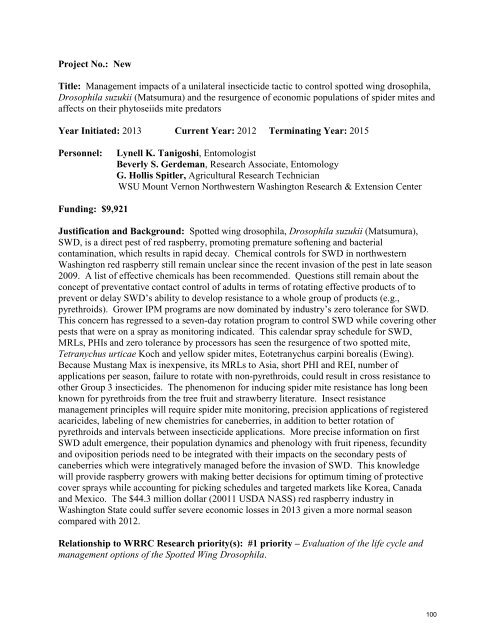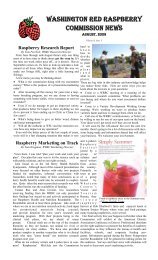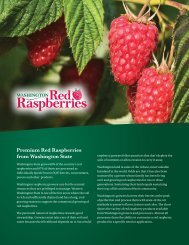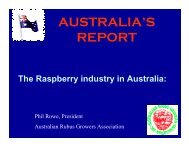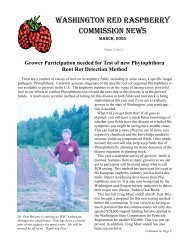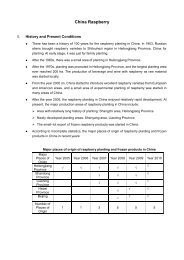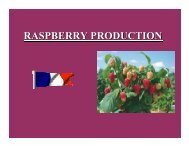2012 - Washington Red Raspberry Commission
2012 - Washington Red Raspberry Commission
2012 - Washington Red Raspberry Commission
You also want an ePaper? Increase the reach of your titles
YUMPU automatically turns print PDFs into web optimized ePapers that Google loves.
Project No.: New<br />
Title: Management impacts of a unilateral insecticide tactic to control spotted wing drosophila,<br />
Drosophila suzukii (Matsumura) and the resurgence of economic populations of spider mites and<br />
affects on their phytoseiids mite predators<br />
Year Initiated: 2013 Current Year: <strong>2012</strong> Terminating Year: 2015<br />
Personnel:<br />
Lynell K. Tanigoshi, Entomologist<br />
Beverly S. Gerdeman, Research Associate, Entomology<br />
G. Hollis Spitler, Agricultural Research Technician<br />
WSU Mount Vernon Northwestern <strong>Washington</strong> Research & Extension Center<br />
Funding: $9,921<br />
Justification and Background: Spotted wing drosophila, Drosophila suzukii (Matsumura),<br />
SWD, is a direct pest of red raspberry, promoting premature softening and bacterial<br />
contamination, which results in rapid decay. Chemical controls for SWD in northwestern<br />
<strong>Washington</strong> red raspberry still remain unclear since the recent invasion of the pest in late season<br />
2009. A list of effective chemicals has been recommended. Questions still remain about the<br />
concept of preventative contact control of adults in terms of rotating effective products of to<br />
prevent or delay SWD’s ability to develop resistance to a whole group of products (e.g.,<br />
pyrethroids). Grower IPM programs are now dominated by industry’s zero tolerance for SWD.<br />
This concern has regressed to a seven-day rotation program to control SWD while covering other<br />
pests that were on a spray as monitoring indicated. This calendar spray schedule for SWD,<br />
MRLs, PHIs and zero tolerance by processors has seen the resurgence of two spotted mite,<br />
Tetranychus urticae Koch and yellow spider mites, Eotetranychus carpini borealis (Ewing).<br />
Because Mustang Max is inexpensive, its MRLs to Asia, short PHI and REI, number of<br />
applications per season, failure to rotate with non-pyrethroids, could result in cross resistance to<br />
other Group 3 insecticides. The phenomenon for inducing spider mite resistance has long been<br />
known for pyrethroids from the tree fruit and strawberry literature. Insect resistance<br />
management principles will require spider mite monitoring, precision applications of registered<br />
acaricides, labeling of new chemistries for caneberries, in addition to better rotation of<br />
pyrethroids and intervals between insecticide applications. More precise information on first<br />
SWD adult emergence, their population dynamics and phenology with fruit ripeness, fecundity<br />
and oviposition periods need to be integrated with their impacts on the secondary pests of<br />
caneberries which were integratively managed before the invasion of SWD. This knowledge<br />
will provide raspberry growers with making better decisions for optimum timing of protective<br />
cover sprays while accounting for picking schedules and targeted markets like Korea, Canada<br />
and Mexico. The $44.3 million dollar (20011 USDA NASS) red raspberry industry in<br />
<strong>Washington</strong> State could suffer severe economic losses in 2013 given a more normal season<br />
compared with <strong>2012</strong>.<br />
Relationship to WRRC Research priority(s): #1 priority – Evaluation of the life cycle and<br />
management options of the Spotted Wing Drosophila.<br />
100


